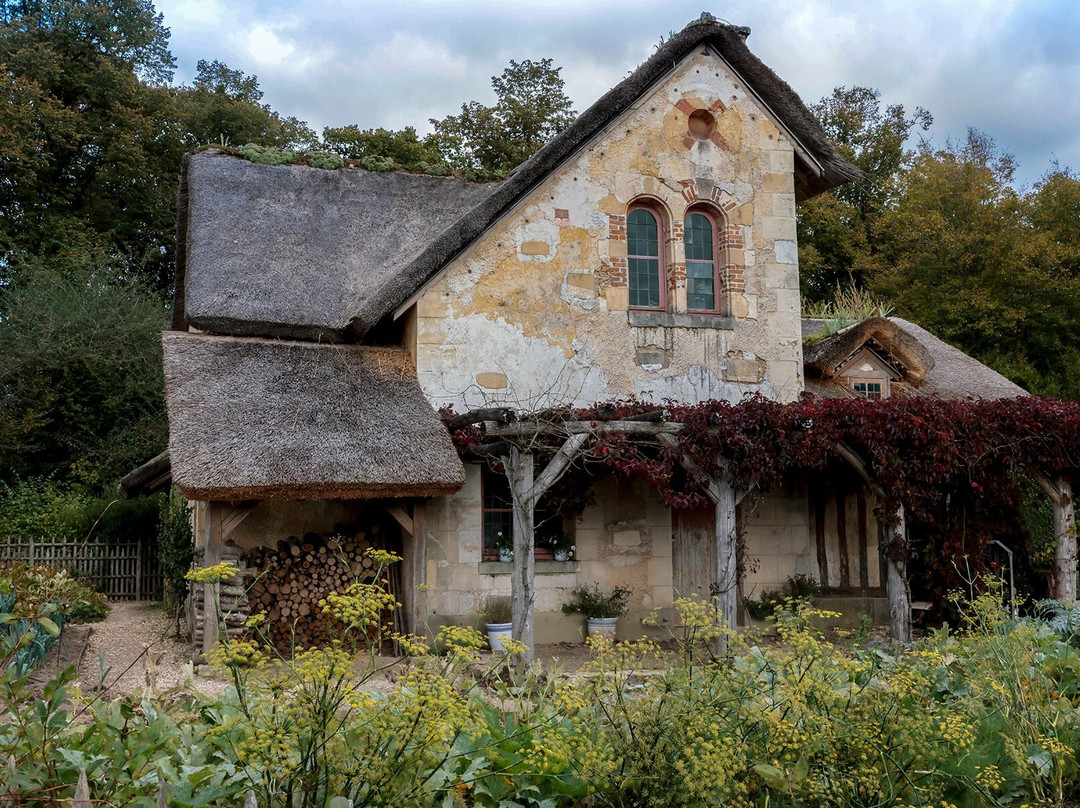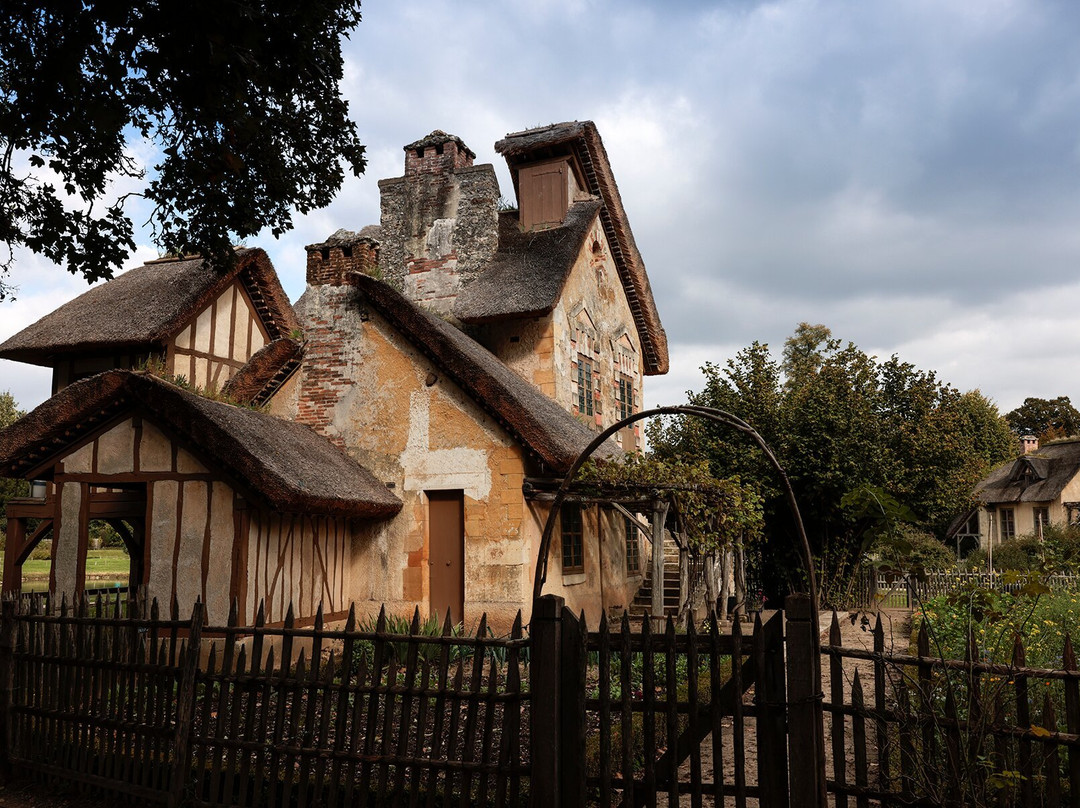的点评
Dairy Queen
Le Hameau De La Reine的点评
点评:When the tassels and brocades, courtly etiquette and official ritual of the Palace of Versailles became too suffocating, Marie Antoinette and her favorites would retreat to the simpler, more bucolic environs of Le Hameau de la Reine—or Queen’s Hamlet, secluded in the palace gardens not far away. There, an entire village had been constructed on the banks of an artificial pond: a farm with a working dairy, dovecot, and water mill—as well as a residence for the queen, a private boudoir, and a guardhouse. Modeled on the rustic cottages of rural Normandy, with their thatched roofs and half-timbering, the buildings belie their richly decorated interiors. In this tranquil setting, the queen could walk with her friends, play billiards, and host more intimate gatherings than would have been possible at the palace. She did not, however, play at being a dairymaid with beribboned sheep and a porcelain milk pail. (There is an explanation for the calumny: In 1783, as work began on the Queen’s hamlet, Louis XVI purchased the nearby Château de Rambouillet. There, as a surprise for his wife and an inducement for her to visit, he had an extravagant “pleasure dairy” secretly constructed to resemble the more modest one at Versailles, where guests could be refreshed with milk and soft cheeses—even ice cream. He also ordered a set of Sèvres porcelain for the dairy. Fabulously expensive, the service, which consisted mostly of cups and saucers, bowls and ewers, was more a showpiece than for general use—but it did include two decorative milk pails, each of which took at least a month to fabricate and were the most expensive pieces of all.) After the French Revolution, the buildings fell into disrepair and would have been ruined utterly had not John D. Rockefeller donated money for their restoration, as part of a larger scheme to restore Versailles. (Rockefeller also funded the reconstruction of Colonial Williamsburg in Virginia). And maintenance is ongoing; when we visited, a small scaffold still was in place at the dovecot. I would like to think that the hamlet was the queen’s favorite part of the entire sprawling estate—certainly, it’s mine.
翻译:当凡尔赛宫的流苏和锦缎、宫廷礼仪和正式仪式让人感到窒息时,玛丽·安托瓦内特和她的宠臣们就会撤退到更简单、更田园风光的王后小村庄,它隐匿在不远处的宫殿花园中。那里,人工池塘的岸边建起了一座完整的村庄:一个拥有奶牛场、鸽舍和水磨坊的农场,以及王后的住所、私人闺房和卫兵室。这些建筑仿照诺曼底乡村的乡村小屋,采用茅草屋顶和半木结构,与其华丽的室内装饰形成鲜明对比。在这个宁静的环境中,王后可以和朋友们一起散步、打台球,举办比在宫殿里更私密的聚会。然而,她并没有扮演一个带着系着缎带的绵羊和瓷制牛奶桶的挤奶女工。 (这种诽谤是有原因的:1783 年,当王后的小村庄开始动工时,路易十六购买了附近的朗布依埃城堡。为了给妻子一个惊喜并吸引她前来拜访,他秘密建造了一座奢华的“休闲乳品厂”,模仿凡尔赛宫的简朴乳品厂,客人可以在那里享用牛奶和软奶酪——甚至冰淇淋。他还为乳品厂订购了一套塞夫勒瓷器。这套餐具价格昂贵,主要包括杯碟、碗和水罐,更像是摆设而非一般用途——但它确实包括两个装饰性的牛奶桶,每个桶至少要花一个月的时间来制作,是所有物品中最昂贵的。)法国大革命后,这些建筑年久失修,如果不是约翰·戴维·洛克菲勒捐款修复它们,它们可能会被彻底毁坏,这是修复凡尔赛宫的更大计划的一部分。 (洛克菲勒还资助了弗吉尼亚州威廉斯堡殖民地的重建)。维护工作仍在进行中;我们参观时,鸽舍旁仍搭着一个小脚手架。我想这个小村庄是女王在整个庞大庄园中最喜欢的部分——当然,也是我的最爱。










此点评仅代表旅行者个人的主观意见,并不代表TripAdvisor以及其合作方的意见。
关于我们
|新闻动态
|商务合作
|会员中心
|业主中心
|常见问题
|意见反馈
|联系我们
|营业执照
© 2025 Tripadvisor 版权所有。
使用条款 |隐私政策 |网站工作原理
部分照片由 VFM Leonardo 提供。
* Tripadvisor不是旅行社,也不是旅游预订服务代理商。我们提供免费、客观、公正的旅游资讯服务。 (显示更多)
TripAdvisor LLC 既不是预订代理商,也不是旅游运营商,不会向网站用户收取任何服务费。 按照规定,在 Tripadvisor 发布机票价格、游览和旅行套餐的合作伙伴(航空公司、旅行提供商及预订代理商),其标价须包含所有费用和附加费用。 例如, 机场出入境税费、消费税与其他服务费、手续费、杂费及附加费用。 当您向我们的某个合作伙伴进行预订时,请务必查阅他们的网站以了解当地行政部门要求的所有适用费用的具体情况。 除非另有说明,机票价格通常指的是一个人的价格(以人民币计)。
为方便起见,TripAdvisor LLC 根据从我们的预订合作伙伴获取的空房率计算每个酒店的均价。 对于游览和景点来说,所显示价格通常是每位成人的最低可用价格。 对于列出的任何旅行套餐或优惠,TripAdvisor LLC 无法保证任何特定的费率或价格。 此外,酒店均价每晚会更新,并以您的首选币种表示(使用现行汇率)。 由于这些已换算的价格是预估价格,因此,有关具体金额和币种请与预订网站进行核实。
此外,TripAdvisor LLC 无法保证我们网站上宣传的价格随时有效。 标价可能需要预订一定天数才能生效,或有不可用日期、使用条件或限制。
TripAdvisor公司对外部网站的内容一概不负责。优惠价格中不含税和其他费用。
ICP证:沪B2-20200433
沪ICP备20013175号
 沪公网安备31010502005427号
沪公网安备31010502005427号鹰程信息技术(上海)有限公司
货币/国家及地区
¥CNY
中国

